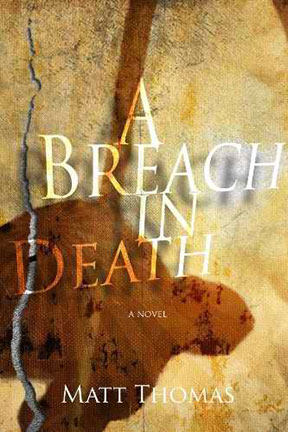


by MATT THOMAS
Boxfire Press, 2013
$12.95, paperback, 978-1938191015
159 pages

Matt Thomas has taken the mythical character of the Grim Reaper, the harbinger of death and the escort into the afterlife, and reimagined it for a 21st century audience. The dark cloaked, scythe carrying skeleton has been replaced with a dark, fitted suit wearing group of men and women working their way out of a purgatory-like sentence. This ambitious first novel, A Breach in Death, is not only a compelling story about the forces of good and evil, redemption, sacrifice, but also a commentary on the importance that the ordinary man plays in upholding social justice. The power hungry cannot go unchallenged and Arc, the newest member of the reapers, learns through a personal journey of loss and shame that he must do what is necessary to save the living.
There is a barrier between the living and the dead. But one reaper has found a way to breach the world of the living, resulting in an apocalyptic world where life and death have no boundaries and where the threat of erasure has replaced the afterlife.
For Thomas's characters the stakes are high. Arc battles his own cowardice and the psychological fears that led to his own death in life. One scene in the novel recounts a poignant moment in Arc’s life when he watches someone drown. He abandons a rescue attempt in favor of self-preservation. Arc listens as the drowning man cries for help. We are simultaneously repulsed by his inaction yet in-touch with the fear responsible for it. In the afterlife it seems as though nothing has changed. Time and again we root for a heroic act only to be disappointed. But his attraction to Lucy, his trainer, and his paternal draw to Remmy, an orphaned child, help him discover an inner strength that overcomes his fear.
Lucy is cold and calculated, but she is conflicted between her loyalties and her feelings for both Arc and Exeter, senior reaper and Lucy's ex-lover. Her murderous past reveals her thirst for revenge, and it threatens her ability to make sound judgments when the fate of the world is at stake. She grows fond of Arc and trusts him to do what's right. It seems as though Thomas gives Lucy this unjustifiable belief in Arc so we might do the same.
Exeter is fed up with the rules of his trade. He doesn't believe that his penance for sins committed in life justify the time he has spent collecting the dead. With the help of an ancient text, Exeter has found a way to disrupt the order of things, finally freeing him of his deathly obligation. Thomas casts Exeter as the villain, the cause of destruction and the end of life, but the real villain is a thought that eats away at each of these characters.
This unholy trinity shares more than a job title. As reapers they are condemned to an afterlife that requires them to change before they can move on. We see in them what they are unable to see in themselves. They are at odds with themselves and each other. We want Arc to become heroic; we want Lucy to forgive; and we want Exeter to repent.
The psychological complexity of these characters is what drives the story to its inevitable conclusion. But Thomas loses his bearings along the way. The novel is at times derailed by a beginner’s mistake—the passage of time. We are led to believe that a majority of the action takes place in twelve hours. The absence of time leaves us feeling like something is missing. As the story unfolds, we forget about hours and days until Arc is injured and left to heal for two weeks, a minor account in the story as a whole. This inconsistency takes us out of the fictional dream and leaves us questioning the time that has passed before. Its placement is almost an afterthought. And the reference to the ancient text appears and disappears when Thomas finds it convenient to do so, again, interrupting the story.
What makes this novel leave an impression is the world Thomas has created after the breach. He takes a familiar landscape like New York and reconstructs it, blending the real with his own vision of hell. As the characters navigate the crumbling city of the living and the dead, the architecture, the epic battles and sacrifices, help define the story: “Like death itself, its city had been defined by an eternity of twists, turns, tunnels and portals. A mystery that evaded the most astute of philosophers and the most savvy of architects. The simplest things were immersed in complication, while objects built in fantasy somehow made sense.”
In the end, Thomas has created a fantasy world that helps us make sense of our own lives. Not unlike Milton, in Paradise Lost, Arc's final thoughts seem reminiscent of Lucifer's after his fall: “The mind is its own place and in itself, can make a Heaven of Hell, a Hell of Heaven.” Likewise, after Arc has rebelled against tyranny and has lost his existence in the process, he concludes: “To maintain that sense of happiness he had never before known, all he had to do was picture how the living would watch his body burst in to a mass of light and race to the stars and clouds above, making his sacrifice, his purpose, known to the world.” The way to salvation and purpose for Arc, and perhaps for all of us, is simply to imagine it.
Reviewed by C.A. Stamidis
C.A. Stamidis is a graduate from the City College of New York M.A. program in creative
writing. He is currently an English teacher on Long Island.
ISSUE:
S U M M E R
2013
SUPPORT THE ARTS
DONATE TODAY
GET A FREE T-SHIRT!
By accessing this site, you accept these Terms and Conditions.
Copyright © 2010-2012 TheWritingDisorder.com ™ — All rights reserved